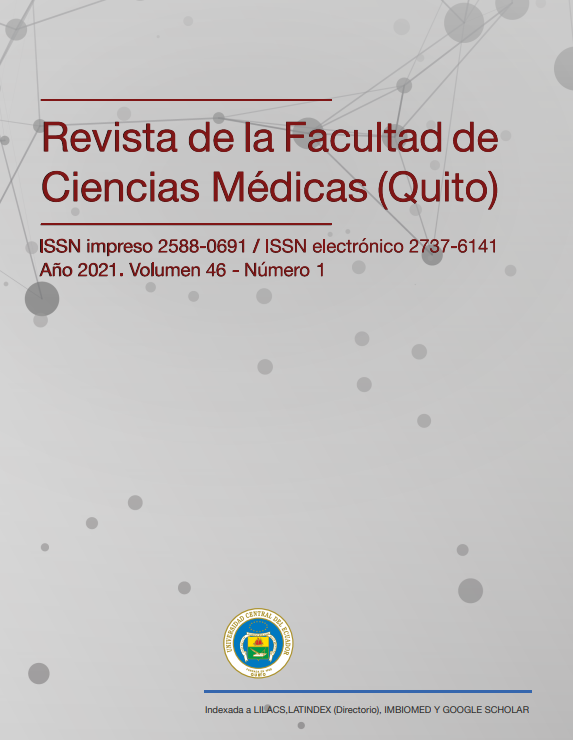The learning environment in times of pandemic
DOI:
https://doi.org/10.29166/rfcmq.v46i1.5181Keywords:
learning environmet, pandemic, teaching-learningAbstract
The World Health Organization declared the pneumonic disease caused by SARS CoV-2 a pandemic, establishing a series of containment measures, such as social isolation, hand washing with plenty of soap, disinfection with alcohol, among others, and the suspension of all public and private face-to-face activities to avoid contact and contagion. The temporary closure and changes in the mode of teaching virtual classes affected 23.4 million higher education students and 1.4 million teachers in Latin America and the Caribbean, representing approximately 98% of the population of students and teachers in higher education in the region. No university in the world was prepared for this disruption from face-to-face to virtual. The demands generated by the application of containment measures forced Institutions of Higher Education to carry out their activities using the Internet as a tool for communication, interaction and expression. Under these conditions, the learning environment changed scenario and moved to every home, not only for students, but also for teachers and administrative staff of Institutions of Higher Education, with a significant impact on the teaching-learning process that should be evaluated to generate mechanisms to support the academic training of future professionals.
Downloads
Metrics
References
WHO. Novel coronavirus (nCoV-19) (Internet). Geneva: WHO; 2020 (Cited December 20,2020). Situation Report – 1. Retrieved from https://www.who.int/docs/default-source/coronaviruse/situation-reports/20200121-sitrep-1-2019-ncov.pdf
WHO. Novel coronavirus (nCoV-19) (Internet). Geneva: WHO; 2020 (Cited December 20,2020). Situation Report – 51. Retrieved from https://www.who.int/docs/default-source/coronaviruse/situation-reports/20200121-sitrep-1-2019-ncov.pdf
El Presidente de la República del Ecuador decreta estado de excepción para evitar la propagación del COVID-19 (Internet). 2020. Retrieved from https://www.comunicacion.gob.ec/el-presidente-lenin-moreno-decreta-estado-de-excepcion-para-evitar-la-propagacion-del-covid-19/
UNESCO-IESALC. COVID-19 y educación superior. De los efectos inmediatos al día después (Internet). Caracas: UNESCO-IESALC; 2020 (Cited December 21, 2020). Retrieved from http://www.iesalc.unesco.org/wpcontent/uploads/2020/05/COVID-19-ES-130520.pdf
INEC. Proyecciones Poblacionales (Internet). Quito: INEC; 2020 (Cited December 21, 2020). Retrieved from https://www.ecuadorencifras.gob.ec/proyecciones-poblacionales/
Santana-Sardi G, Gutierrez-Santana J, Zambrano-Palacios V, Castro-Coello, R. La Educación Superior ecuatoriana en tiempo de la pandemia de Covid-19. Dom Cien (Internet). 2020 (Cited November 18, 2020); 6(3):757-775. Available in http://doi.org/10.23857/dc.v6i3.1428
CES. CES Aprueba normativa transitoria por emergencia sanitaria (Internet). Quito: CES; 2020 (Cited December 21, 2020). Retrieved from https://www.ces.gob.ec/?te_announcements=ces-aprueba-normativa-transitoria-por-emergencia-sanitaria-31-03-2020
Watermeyer R, Crick T, Knight C, Goodall J. COVID-19 and digital disruption in UK universities: afflictions and affordances of emergency online migration. High Educ (Dordr)(Internet). 2020 (Cited November 20, 2020); 1-19. Available in http://doi.org/10.1007/s10734-020-00561-y
Schwarz M, Scherrer A, Hohmann C, Heiberg J, Brugger A, & Nunez-Jimenez A. COVID-19 and the academy: It is time for going digital. Energy Res Soc Sci (Internet). 2020 (Cited November 25, 2020); 68, 101684. Available in http://doi.org/10.1016/j.erss.2020.101684
Macias-Silva E, Aquino-Rojas M, Rodriguez-Pillajo L, Edgar HA. Impact of ICT on virtual learning. Dom Cien (Internet). 2020 (Cited November 18, 2020); 6(3):1065-1076. Available in http://doi.org/10.23857/dc.v6i3.1337
CES. CES Reforma la normativa transitoria para el desarrollo de actividades académicas en las IES (Internet). Quito: CES; 2020 (Cited December 21, 2020). Retrieved from https://www.ces.gob.ec/?te_announcements=ces-reforma-la-normativa-transitoria-para-el-desarrollo-de-actividades-academicas-en-las-ies-07-05-2020
Abdulkareem T, Eidan S. Online Learning for Higher Education Continuity (during COVID-19 Pandemic). Int J Youth Eco (Internet). 2020 (Cited November 20, 2020); 4(2):125-134. Available in http://doi.org/10.18576/ijye/040206
Genn JM. AMEE Medical Education Guide No. 23 (Part 1): Curriculum, environment, climate, quality and change in medical education-a unifying perspective. Med Teach (Internet). 2001 (Cited November 21, 2020); 23(4):337-344. Available in http://doi.org/10.1080/01421590120063330
Genn JM. AMEE Medical Education Guide No. 23 (Part 2): Curriculum, environment, climate, quality and change in medical education - a unifying perspective. Med Teach (Internet). 2001 (Cited November 21, 2020); 23(5):445-454. http://doi.org/10.1080/01421590120075661
Miles S, Leinster SJ. (2007). Medical students' perceptions of their educational environment: expected versus actual perceptions. Med Educ (Internet). 2007 (Cited November 21, 2020); 41(3):265-272. http://doi.org/10.1111/j.1365-2929.2007.02686.x
Downloads
Published
How to Cite
Issue
Section
License
Copyright (c) 2021 Marco Guerrero F

This work is licensed under a Creative Commons Attribution-NonCommercial-NoDerivatives 4.0 International License.










